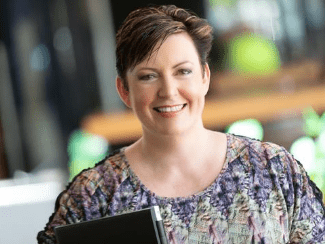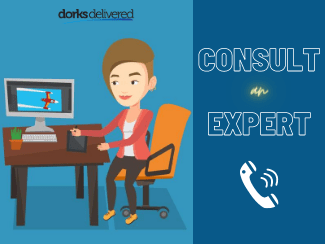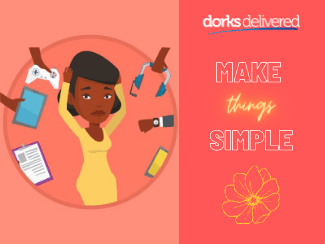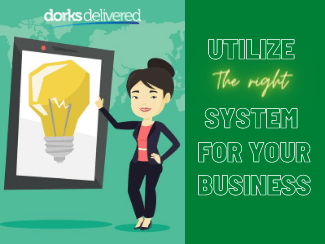Although your company is running smoothly, you can still make things better. Ensuring the efficiency within your business will play a vital role in your future success. The more your business gets bigger, the more you have to consider several factors in keeping your settings efficient and productive. We can’t avoid situations like, a project gets hung up for a few days, or some meetings that once felt productive seems to drag on for hours, but as a business owner, you have to keep in mind that getting that traction and focus back in place should be your main priority. Feedback from experts and employees are also relevant to the process. So in this episode, Sarah Steins shares her thoughts on how to stay efficient in your business.
Josh: Gday everyone out there in the podcast world. We’ve got Sarah from Miss Efficiency. We’re going to be talking today about how recession-proof your cash flow through efficiency in business. Sarah actually wrote a pretty cool white paper on how to remove the paper from your business, which, I guess a bit of an interesting way of looking at it. So Sarah, in business, people are freaking out in business at the moment. If you’re still in business, hopefully, what would you say is the number one way to stay efficient, and make sure that you keep your head on the right numbers?

So I think to have really good accounting software in place, and then something really good to keep track of your workflow depending on what your businesses and then something to keep track of your customers, and your leads, and, you know, CRM, if you like so that you can keep in front of everybody. So to answer your question, map it out, and then decide what you need. And then, you know, it can evolve and grow from there. It doesn’t mean that because you’ve decided on this today, that’s how it needs to stay forever. It just evolves as your business needs change.
If you need assistance with your automation, talk to a dork. Fill out the form below to book a free one-hour consultation
Josh: You’re talking before about do you need this card? Do you need an upgraded car? Is this car fine? I’m guilty of being fooled, I’m going to use the term “fooled” into selling a perfectly good car to make sure that the image that I was representing was what was required by the business and it made no difference at all. No one cared about my car whatsoever. I dropped out a perfectly good car that was perfectly functional, the four-wheel-drive that I still have now is still perfectly fine and functional. But oh, man, what a ripoff. Just coming back to like what you need in your business. And what is the tech that would be good to check out? You told me the different accounting packages, obviously. You touched on some bits and bits about leads versus customers and stuff, which we’ll talk about in a bit. But 
Sarah: I would say talk to your bookkeeper or your best agent, but you know, you’ve ruined that, you’ve ruined that. I think in this instance, cars aren’t really our forte. But I think definitely talk to the people who are experts in using it. Do some research. Don’t do too much research online because there’s too much information. I know if I go online, yeah, there’s just too much and it’s too overwhelming. And it’s like, that’s all too hard. I’m not going to do it. Talk to other business owners that you know. So I had a phone call today from a client who was with a friend of theirs who is in a different business to them. So all my clients are on Xero and the friend of theirs was on MIB. And he was having trouble and he was thinking about converting over. So my client got me on the phone, we had a three-way conversation and you know, I could give them some information about MIB and Xero and a few other bits and pieces. So talk to other business owners that you know who are friends because they have a vested interest in it. So they are going to tell you the truth. And it’s good to get in You know, other people’s perspective, like how we would use Xero for my existing client would be different to how we would have used it for this other business owner.
So definitely do your research. But I think, also come in prepared with the knowledge of what you need. So coming back to my scenario before about mapping out what you need. Think about what your current processes are, and evaluate what’s manual, what’s electronic, what’s taking you the most time, what’s the thing that you push around your desk the most before you realize, you know, you actually have to do it now. And then think about what your workflow is, what you would like it to be if there’s something that you want to be able to do that your current systems don’t allow you to do, to have a really good idea of what your needs are. So then when you talk to an advisor, they can say, okay, well based on that, this is what we would suggest to put in place, and based on what your needs are. We have a conversation with people to try and find out what they are currently doing what they would like to do and where they see their business in a few years’ time because maybe what’s going to work for them. Now, that might not work in five years’ time. So if we don’t think about the bigger picture, you might be doing the wrong thing.
So do some research, educate yourself have a clear idea of what you want to get out of the system. And then you can have a really good conversation with an accountant or agent who can help you then put it into place.
IT doesn’t have to be expensive. If you’re starting a business and need reliable IT support and services, fill out the form to learn more about $1 IT services.
Josh: That makes a lot of sense. And I know that when I started the business, I decided I’m going to learn everything and I’m going to be the person who wears all the hats and develop the software that worked exactly as I wanted to. I hated the idea of bookkeeping myself, and so I learned everything I could about it so that I could try and do it in an automated way. I ended up just spending too much time making this software instead of working in the business. Fast forward 12, 13 years we’ve got fantastic options out there like Xero, mostly online products that do 95% of the reconciliation. And as long as you’ve got the good bookkeepers in there that can make sure that when there is an anomaly, they’re picking up on that and striking that out and making sure that they bring the attention to and fixing it. And we’re in a better world now than when I first started building all this stuff out.
One thing that I have found, though, is that we introduce into our software stack a better way to manage inbound leads and making sure that we were able to see if people were interested in our services. We’re making sure we’re able to see what stage they are at, which is a very different kettle of fish to a lot of the managing an existing customer that’s already spending money with you that you’re making an invoice and doing service with. When it comes to that, do you differentiate? Or do you see a reason to differentiate between prospects leads and customers?
Sarah: So when I first started my business, I was a very good bookkeeper. And I had to learn that I had to be a better business person because it didn’t matter how good I was at, you know, bookkeeping. If I was a crap business person, then I was going to have a crap business. So I had to learn all of these things very, very quickly, and it was a very steep learning curve. And I’m by no means the expert. So, I don’t really differentiate leads and prospects. I just think that either clients or soon to be clients. And that’s it. And I am quiet, I don’t know if basic is the right word, but I like to keep things simple. Because we were super busy and we’re highly systematised and you know, there’s a few of us in our team, we want to make sure it’s easy for everybody to follow. And I think if you over complicate things, that’s where, you know, cracks start to show. So we use a program called Active Campaign. I can’t remember what the other is called. It’s like the monkey is the logo. MailChimp. Yeah. So that was great. But all I did was send out the occasional newsletter, and it probably did a lot of things that I didn’t do, but that was my failing rather than MailChimp’s failing. But then I moved into Active Campaign and I love Active Campaign. And as part of my onboarding process, like I have quite an extensive onboarding process, but Active Campaign drives a lot of that for me. So everybody goes into Active Campaign, I’ve got a download from my website. So once you download that, their information goes through. If people book online appointments with me, it goes through Calendly. Again, that automatically filters through to Active Campaign. So I think it’s really important to capture a lot of this information, but it’s really important to use the automation to do it for you so that you can concentrate on the gold nuggets.
Do you need help with backup and recovery? Fill out the form to get in touch with a Dork.
But one of the things that I do so I send out regular communications and with the recent COVID events, I was sending out lots of information because I’m conscious of not bombarding people with too much information, but during that period, there was a lot of stuff to get out. So I was sending just about an update out every couple of days, just about, and I got so many messages back saying, this is amazing, thank you so much for sending it through, it’s really nice to be able to have this information come through and we don’t have to, you know, try and find it and work our way through. And these are comments from people that aren’t even my clients, you know, so that was really great.
Josh: The beautiful thing about that, like if you’re producing that without like it, you’re producing that and throwing bloody Aussie accent and I understand what you’re blooming saying as opposed to some of the legislative legal crap you read on some of the government, nothing against the government websites, but you just read it you go, okay, why did Betty bend. Some of the examples I’m reading, this makes no sense. This is too hard.

Josh: Oh, absolutely. I had a look, and I read the sentence twice. And I thought, okay, I missed the comma on the first time, and it completely changed the meaning of the sentence. And I bought that for my account. And I said, How do you interpret this? And this was on one of the cash flow stimulus things. And he interpreted it in the polar opposite way that I did. And we ended up coming to a conclusion that yes, he’ll do some more research and find out the answer for us like, you’re exactly right. It can make it more complicated than what it would be helpful.
Sarah: Yes, yeah. But one of the really cool things just coming back to Active Campaign, which is one of the things that I love about it, is when I get a new client. So in the old days, I would send them an email because I’m very much a word skill. I will always say the name up before I pick up the phone, although COVID has changed that slightly, but in the old days, I would send a new client an email that was, if they’d printed it out, it would have been 15 pages long with all of the information that I thought that they needed to know. And you know, realistically I know that they’re not going to read that, because who has time to read a 15-page email seriously. So one of the things that I’ve done in Active Campaign is part of, you know, a few other programs that I’ve got linked together when a new client comes on board. I haven’t onboarding automation that triggers through Active Campaign. So as soon as they get the tag on their contact if you like that they are now a client. This automation automatically triggers and it’s basically that 15-page email drip-feeds out over a number of weeks. So it’s not too much information for this client to read. And, you know, the very first email is basically saying welcome. And that’s it, you know, it’s like a couple of paragraphs, and that’s it. Then the next day, they’ll get one saying, this is what you can expect next. And that’s it. Just, you know, there are images in it and it’s nice and pretty and easy to read. Then a couple of days later, they’ll get one that introduces them to the team. How they should communicate with us. And then three days later, they’ll get one that shows them how to set up receipt bank. Within this time period, I’m working in their file and have set up receipt bank. So it’s all really nice and seamless. And so it gets the information to the client that I need them to see. It gets delivered to them in a format that’s easy for them to read. And it’s just keeping those touchpoints. So then I think there are about 10 emails that they get delivered out over the course of six weeks. And by the end of it, you know, we might have done the best, we’ve pulled everything together. It’s just a really nice introduction. I think that’s the way that I intend for the relationship to be so that’s how it starts. And it’s getting some really nice groundwork at the beginning of the relationship.
IT doesn’t have to be expensive. If you’re starting a business and need reliable IT support and services, fill out the form to learn more about $1 IT services.
Josh: Similar to what you said actually on this. I started off the same. I was fantastic at I could cure cancer for computers. But if that said on the show, it’s not going to be any benefit to anyone. So I had to become better at marketing and better business in that sense. What you’ve said there, you’ve increased the number of touchpoints, you’ve decreased the friction on them not reading the email saying I’ll do that later because it’s too long. And I’ll tell you right now, I’ve got two emails sitting there. He said, he’s attached a Word document, he said, look on page four, section three, that’s a bit of thing is going to be most interesting, but make sure to read the whole lot first. And I was like, ah, I’ve got other stuff to do. You’ve removed the friction, which is great. You’ve increased the touchpoints, which is great. You’ve built these all in an automated way, which means you’re not sitting there having to do this or group it to them. Out of interest did you build it all out yourself?
Sarah: I’m a bit of a control freak. So I did do it myself. But I’m super proud that I was pregnant and I’ve had the baby at the end of it. There was this baby. It’s like, yeah, look what I did. So it was very, very cool. I really, really enjoyed doing it. and it was completely outside of my comfort zone, but the Active Campaign is amazing. I mean, they’re American based. I think they have some, some support people in Australia, but they were just awesome. I did have a couple of little triggering issues. But I got onto the support team, and they helped me and that was just, it works brilliantly. So I’ve done a few of those now. So yeah, and I love Active Campaign.
Josh: You’re preaching to the preacher, okay. Not a half years ago, and we started using Active Campaign thought it was absolutely the best thing since sliced bread. And it has just never ceased to amaze us. Every single part of it’s amazing
Sarah: But some of your listeners that might be thinking, ah, that’s just too hard. Or they might jump in and think, oh, you know, it’s really, really complicated. It’s really not. I’m someone who deals with technology every day, but I have my little comfort bubble as well. And so when I first started with Active Campaign, it was way outside my comfort zone. The person that put me on to Active Campaign, I said, you know, I’m a bit of a technophobe. And he’s like, what do you mean? You are the biggest propellerhead I know. And I’m like, so funny but he would say that. But I didn’t know it. I just was a little bit patient with myself and kind to myself, you know, I can work this out. And there are hundreds of people that will do it for you. If you want someone to maybe just build the bones of it for you. And then you’re good to run with it. Yeah, I did it myself because it’s a bit of that control thing. I think it’s great and like I said, this heaps more that I could do with it, but this is working for me at the moment.
IT is indispensable but it shouldn’t cost hundreds of dollars. Fill out the form to learn more about our budget-friendly on-demand IT solutions.
Josh: I think it’s something everyone should be having in business. It is a lifesaver for us. My partner Sarah, her whole business is set up completely in Active Campaign. This podcast sounds like a commercial for Active Campaign. But her business, hair and makeup business from start to finish is completely Active Campaign. People come through on her website, she’s able to see if they’ve clicked through from AdWords, she is able to see where their sources are, if they fill out a form, once they fill out the form and then sends them a welcome email and then a would you like to get a quote and then 
She’s asleep watching and then they’ve already got a quote they’ve already got a tentative date in mind, she has a quick phone call with them, make sure that they’re all happy to understand what they want. And there’s nothing out of the ordinary that they’re looking to get to this special day. Then after that automatically sends across into her calendar takes all the payments and sends out for review emails in bits and pieces later. She’s managing a team of five staff, the meat and gravy that the most of it is all Active Campaign. So I think it’s great and it’s definitely a tool that makes businesses more efficient. I’m really happy to hear from you using it. Something that when we talk to businesses a lot of time they’re like, oh, what’s Active Campaign. Oh no, we use MailChimp. It’s fine. And from your perspective, when you took the leap, how would you for someone who is using MailChimp without throwing dirt at them, like, how would you say the differences between the two products? They’re both great products, but they’re both different products.
Sarah: Okay, so I think it’s like doing your accounts in Excel and then going to Xero. You know, they both give you the same outcome. They both do the same thing, you’re tracking your expenses or whatever, but there’s just, you know, it’s just a lot prettier. It does an awesome job, it’s easier for you. There’s less grunt work. And, I enjoyed it, I didn’t mind MailChimp, it was easy for me to use, but literally, all I did was send newsletters, and I didn’t do it very regularly. I was pretty useless at being regular. I didn’t track any of the reporting. I’m pretty sure it does do some automation, but I didn’t know about it and didn’t know how to do it. And I was probably on the free version. So I didn’t see the value in it, maybe if I was paying for it, I would have worked harder at it. So I don’t think actually, it’s an issue with MailChimp, it was a totally my issue. But then when I moved to Active Campaign, I just noticed all the bells and whistles that may or may not be in MailChimp. I think to make the move to it, it had a mindset shift for me as well about okay, I’ve got to get serious and I’ve got to do this.
IT doesn’t have to be expensive. If you’re starting a business and need reliable IT support and services, fill out the form to learn more about $1 IT services.
So I’ve been in business 18 years, I moved to Active Campaign within the last five years. So it just goes to show that you don’t have to have all of your ducks in a row within the first year or two. And, they’re constantly moving anyway. You know, sometimes I’ll make a big change to my business or you know, there’ll be a big shift, and they’re often is at various times and I often referred to myself, as you know, a 15-year-old startup or an 18-year-old startup Because it seems so new now because we’ve made such a big change. And it doesn’t mean that necessarily you were doing things wrong before. It just means your business has changed and you’ve evolved with the way that you do things.
Josh: The Excel versus Xero analogy. I’m going to use again if that’s okay with you, that’s amazing, that’s perfect. In my opinion, MailChimp is fantastic at making campaigns or newsletters. It’s not fantastic at allowing for touchpoints and customer attention and interactions and seeing what they’re doing on your website and how they’re working with you and tagging and then integrating into other systems, and Active Campaign has its campaigns. And if you’re comparing the two, Active Campaign’s campaign module versus MailChimp is what I’d say is about the same but it’s just there’s so much more in Active Campaign versus MailChimp.
But if anyone is interested actually in checking out a little bit more on how some of this automation can work, Sarah has got a little gift for you. And that’s if you jump across to Missefficiency.com/book, you can jump on there. She’s got the ability for you to check out how to save up to five hours, is that right of your workweek?
Sarah: Yes. So there’s a free download on my website, which gives you the tools to be able to, say, five hours a week and your business. It basically comes back to systems and technology. And, that’s all it is. I think you can be, anybody can build a great business that I think the fundamentals comes down to people, technology, and the systems that you put in place.
I’ve actually written a book, and like, it’s not a download. It’s an actual book, and it’s all about systematising your business. It’s called “Wow, I’m in Business… Your Journey From Overwhelmed to Organised”, and I did write it based on an experience that I had with a client. So one of the other programs we use is Dropbox, which you there’s lots of other programs that are similar to that. That’s just the one that we use. But I had a client, that’s still a client, they own a pub in Central Queensland. And they’ve had it for a while. And the client rang me one day during the week and said, You know, I’m completely overwhelmed. I need you to come and just sort things out. And we’d already put in place Xero and you know, a few other bits and pieces and I’m like, Oh, okay. She says, you just have to come. So she booked me on a flight. And the next Friday, I was heading up there, and I spent the weekend there. They live about an hour and a half from the airport. So she’d come and pick me up and I had known her for a long time. She came and picked me up from the airport, and we were driving out there. And I could tell that she was super, super stressed and just wasn’t herself, because I would always see her in Brisbane and you know, she’s bubbly and bright, and yeah, I could tell that she was really, really stressed and overwhelmed. And anyway, I spent four days out there, and I didn’t do a great deal.
Do you want to learn more about technology for business? Fill out the form below to get a callback.
So they’ve got a pub, a restaurant, a bottle shop and some cabin accommodation. We already had Receipt Bank and Xero. So I put in Dropbox so that she would have a place to store her information. I developed some forms for her staff so that she’d have employee packs. I developed some forms that could be used for bookings and accommodation. So we couldn’t put too much technology and because the internet up there is not always that great. So, I just did a few bits and pieces like that. I didn’t think it was anything too major. It just seemed like common sense to me. But then when she was driving 
So the first thing that the book talks about is reigniting that passion. And then we can talk about putting systems in place. There are lots of templates and bits and pieces that you can download from the website. But it was kind of life-changing for me as well because I sort of took for granted how easy it is for me, but it’s not always easy for other people. But it’s the same effect if I turn it around if I go into some buddies business where I’m needing help, I’m completely overwhelmed, but it’s really easy for them. So yeah, that’s what the book is about.
Josh: Well, I definitely think if anyone is interested in the book sounds like a great story that’s I know I’m in the process of writing another book myself. One of my friends said, if you think reading books, try writing a book. What you said there is actually really, really good. Sometimes you have the knowledge and you take it for granted that everyone has that same knowledge and you’ve got these hidden gems that you help people out and they just overly grateful, and sometimes I felt I thought people were being like, taking the piss.
If anyone is looking for a bookkeeper who goes above and beyond and is 100%, not your ordinary book make sure you contact Sarah, Miss Efficiency, she’s going to be able to help you out. And as you can already hear from a wonderful knowledge, she’s stubborn enough to stick in there and make sure that she’s putting in the right solutions for you. Yeah. Is there anything else you’d like to go through before we finish off on the podcast?
Sarah: We’ve probably touched on some really good stuff. Maybe we’ll save this for another occasion. But I think cash flow would be the next conversation to have that can take your business to the next level. And particularly in times like these, you know, who would have thought there would ever be, you know, a pandemic in our lifetime. If that doesn’t make you realise how important good financial literacy is, then nothing will.
Josh: Probably save it for another time for the moment. It’s own episode in its entirety, I think. But I really appreciate you coming on the episode and giving our listeners a bit of a view into the things that you do.
Sarah: Thank you for having me.
Josh: If anyone has any questions, make sure to jump across to miss efficiency.com.au, and leave us some love. If you have any comments and reviews for us, make sure to jump across iTunes. Leave us some love. Give us some feedback. And everyone, stay well out there with the COVID around the place and stay healthy.




























